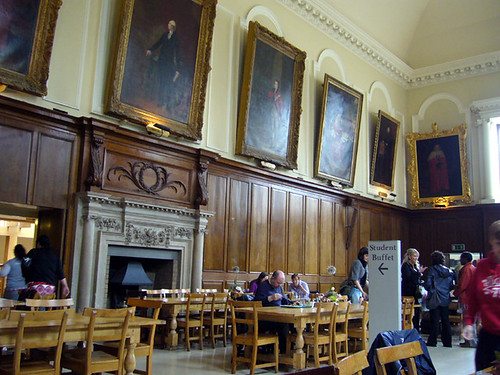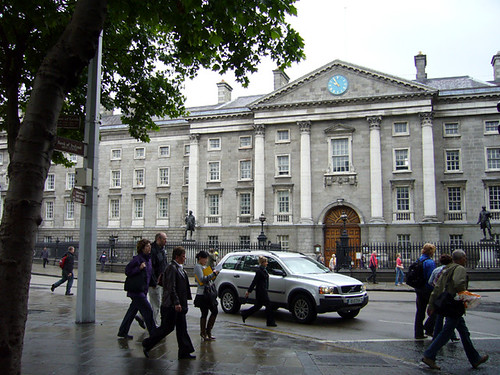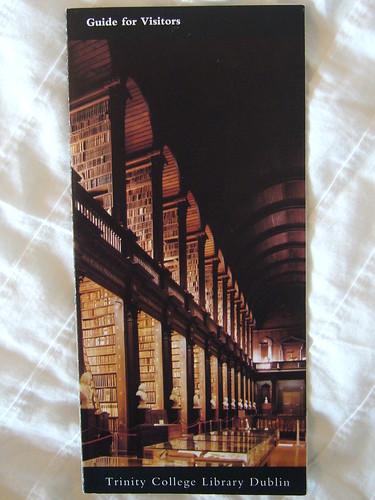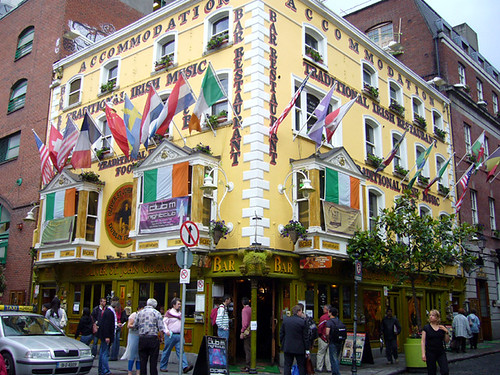Grüße aus...Ireland! Part I: Dublin
I had a wonderful Birthday!! Thanks to all of you who gave cards or phone calls or other well-wishes!
Several months ago, I informed Karl that I wanted to go to Ireland for my birthday. He was fully supportive. So on June 19th, I got on a plane to Dublin and I spent three days there and then traveled to the Dingle Peninsula for another three days. It was an absolutely marvelous journey!
Dublin was fun! It is a very urban city and I learned a lot about it's history, as well as the history of Ireland, while I was there. Ireland has a complex and oppressive history. Its economy has been spiraling downward since the Great Potato Famine of the 1840s...until suddenly in the 1990s when it has since become the "Celtic Tiger": one of the strongest economies in Europe.
I learned that Ireland was a bi-lingual country. I knew that the native tongue of Ireland was Irish (or Gaelic) but I didn't realize how prominent the language was. Everything was written in both Irish and English. I heard some Irish spoken and sung during my time there and It sounds nothing like English, nor anything else I've ever heard but I found it quite beautiful.
I also realized throughout my travels how many great writers and poets came from Ireland: James Joyce, W.B. Yeats, Oscar Wilde, Jonathan Swift... In fact, the Irish are known for their writers and their gift of gab. So, during my trip I decided I would immerse myself in Irish writers and I began reading James Joyce's A Portrait of the Artist as a Young Man as the plane took off!
"The grey block of Trinity on his left, set heavily in the city's ignorance like a great dull stone set in a cumbrous ring..." -James Joyce, A Portrait of the Artist as a Young Man
On my first morning, I took a tour of Trinity College, the most prestigious university in Ireland. The college site was originally a monastery. It was closed by Henry VIII when he formed the Church of England and in 1592, his daughter, Queen Elizabeth I, created a university on the site. The original monastery buildings are long gone (the only thing remaining is the bell in the the central bell tower in the main square) and the oldest buildings at the college now were built during the mid-1700s. (In fact, I noticed that most of the great buildings throughout Dublin were built in the the 1700s...the hey-day of Dublin, apparently.) There is a chapel and an examination hall directly across a square from each other and identical to each other. (We were told by the Trinity College graduate guide that on examination days you literally see students making paths back and forth between the chapel and their exams!) The Chapel is unique in that is was the first church in Ireland that was consecrated for the services of all the 4 religions of Ireland at the time: the Catholic church and the three Protestant churches. We also stood underneath a very large Oregon Maple Tree...the largest Oregon Maple in Europe. Two of these large trees were planted in what was the monastery graveyard (which is probably why they grew so large!) in 1820.
Our tour ended at the Old Library where I entered to see the Book of Kells! This is an illuminated manuscript of the four Gospels, beautifully decorated! It is more than 1,000 years old! After viewing the book I was able to walk through the Old Library's Long Room. This is the main chamber of the library, built in 1712, is 65 meters long, and holds 200,000 of the library's oldest books and it was truly stunning! Unfortunately, photography was not allowed, but believe me, it was beautiful (here's a shot of the brochure from the library)!
Two stories of old leather-bound books, underneath a wooden vaulted ceiling! All the books were organized by size: the large books on the bottom shelves and the smaller books on the top shelves. I didn't want to leave. But leave I did eventually because I had to find some lunch. On my way back through the campus I noticed that the old 18th century Dining Hall next to the Chapel was open for visitors. So I had my lunch sitting in the old Dining Hall of Trinity College surrounded by wood paneling and large portraits of past chancellors.

After my historical-feeling lunch, I made my way down historical Nassau street to the National Gallery of Ireland. I had wanted to visit this museum to see this particular artwork but I was delighted to find that there were so many more treasures there! I spent my afternoon wandering around its beautiful galleries seeing French Impressionists, Italian masters, incredible Dutch masters, and discovering some wonderful Irish artists.
Later that day I saw the exteriors of St. Patrick's Cathedral and Christ's Church Cathedral (both were closed to visitors at the time, one because they were getting prepared for a performance, the other because a TV show was filming there). But that evening I did something that really made me feel like I had arrived in Ireland: I hit the pubs!
"A good puzzle would be to cross Ireland without passing a pub." -James Joyce, Ulysses
Yes, even I, a non-drinker, couldn't pass through Ireland without hitting the pubs! But instead of going for the Guinness, I went for the music! I participated in a Traditional Irish Musical Pub Crawl. This tour became at this slightly touristy but historical Gogarty's Pub on Temple Bar...
...and continued to two other pubs in the area over the course of 2 1/2 hours. Our guides were two traditional Irish musicians who played both old and new Irish music as everyone sipped their beers. I had a wonderful evening! I've always like traditional Irish music, but it sounds about 10 times better in a comfortable Irish pub. At the last pub, the musicians gave us what they called the Noble Call: they explained that normally at a session (that's what it's called when the Irish gather around, normally at a pub or a home, and talk and make music) everyone is expected to contribute and so they asked us tourists to share some song or something. A woman from Ohio sang an old Shaker song. An English woman sang a little song she sings for her two-year-old. And then, since no one else was volunteering, I raised my hand, stood up, and sang Johnny Cash's song Delia's Gone! Yep! I sang in an Irish pub!
I enjoyed the pubs and the music so much that when the crawl ended I wandered back to Gogarty's Pub to enjoy more traditional music until past midnight. They had a young group playing traditional Irish instruments who mixed traditional tunes with more modern covers: you haven't heard Metallica until you've heard it sung to an acoustic guitar, a flute, a fiddle, and an Irish drum!
All changed, changed utterly:
A terrible beauty is born.
-W.B. Yeats, Easter 1916
The next morning I took a walking tour of Dublin. This was an excellent tour of the city by a history graduate who enlightened me on both the interesting history of Dublin and the fascinating history of Ireland. Their history is full of invasions and resistance which finally resulted in an independent Republic of Ireland...unfortunately the country is still not united. The Irish still work for the day when Northern Ireland, still under British control, becomes united with the Republic. This guard box at Dublin Castle use to be red with a gold crown for the British royalty and housed guards during the time when Ireland was controlled by Britain. Now the boxes are empty, black, and carry the Irish harp as a symbol of the independence of present-day Republic of Ireland. (Take a look at my photos of the trip for some more details from the tour!)

After a lunch of traditional fish and chips (they were even wrapped up in news print) sitting in the park behind St. Patrick's Cathedral, I went to the Chester Beatty Library behind Dublin Castle. This is one of the world's greatest collection of books and manuscripts, some of them more than a millennium old! I learned from our tour guide that morning that the Library was having an exhibition on Leonardo da Vinci's Leicester Codex! This is a collection of his scientific writings on his theories on the motion of water. It was fairly recently purchased by Bill Gates and was now on display in Dublin! So I wandered through a darkened gallery looking at Leonardo's sketches of water and backwards handwriting for an hour or two. They also had on display several books from the Library's collection, old scientific books that would have been available to Leonardo in the fifteenth century.

After the exhibition I walked through the drizzling rain down historic Grafton Street and through part of the large city park of St. Stephen's Green to another museum: Number Twenty-Nine. This is a restored Georgian (Neoclassical) townhouse at number 29 Lower Fitzwilliam Street in Dublin. The home was built in 1790 in a then-new neighborhood, now famously lined with many-colored Georgian doorways. The home was restored to its original condition and I was able to tour through its elegant and beautifully simple rooms. I loved this tour! Unfortunately, we weren't allowed to take photos, but here is a link to the museum's website where you can take a virtual tour (I especially loved the stenciling on the wooden floorboards of the governess's room).
That night I attended a performance at the Gate Theater: Sweeny Todd: the Demon Barber of Fleet Street. This was a Steven Sondheim musical that my sister (the musical queen) recommended. The story was from an actual London legend of a barber who killed his costumers that were then cooked into meat pies by his neighbor. The musical form of the legend was just as creepy and very good!
The next morning I woke early to take a bus, then a train, then another train, then another bus to the Dingle Peninsula! But more on that adventure later...
Dublin was a lot of fun and I began to fall in love with Ireland there. It was fun to be reading James Joyce, whose books take place in Dublin, while I was exploring the city. I noticed many landmarks marking places that appear in his books. In fact, I learned that I just missed one of the biggest holidays in Dublin: Bloomsday on June 16th. Joyce's masterwork, Uylsses, takes place on one day in Dublin, June 16, 1904. So Dublin celebrates Joyce and his book and their city every June 16th! Hmmm....maybe I'll be spending another birthday in Ireland next year! See my Dublin photos here!




No comments:
Post a Comment